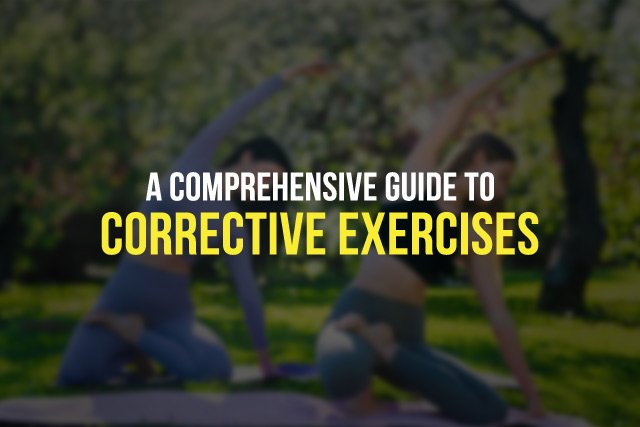
In pursuing a healthier, pain-free existence, corrective exercises emerge as a beacon, guiding individuals towards improved posture, enhanced balance, and optimal musculoskeletal function. This comprehensive guide aims to demystify corrective exercises, exploring their benefits, the Corrective Exercise Continuum (CEX), targeted impairments, and practical steps to get started.
1. Understanding Corrective Exercises

Our bodies are dynamic, adapting to daily activities and surroundings. Unfortunately, this adaptation can lead to inefficient movement patterns, discomfort, and potential injuries. Corrective exercise is a personalized solution that addresses imbalances, weaknesses, and dysfunctional patterns to promote overall function.
1.1. Tailored Solutions for Common Issues
- Desk Workers: Combat tight hip flexors with corrective exercises targeting hip and back muscles.
- Weightlifters: Correct muscle imbalances through targeted exercises like deadlifting and powerlifting to enhance overall performance.
- Aging Individuals: Counteract inefficient movement patterns related to aging with exercises promoting balance and stability.
2. The Benefits of Corrective Exercises Training

Corrective exercise offers many advantages, shaping a more resilient and functional body.
2.1. Improved Posture
- How: Stretching tight muscles and strengthening weak ones.
- Why: Reduces neck pain, back pain, and shoulder pain, improves breathing, and minimizes fatigue.
2.2. Improved Balance
- How: Strengthening muscles and enhancing coordination.
- Why: Prevents falls and injuries, promoting stability during movement.
2.3. Improved Coordination
- How: Enhancing muscle strength and balance.
- Why: Reduces clumsiness and minimizes the risk of falls and injuries.
2.4. Reduced Pain and Injuries
- How: Restoring normal movement patterns.
- Why: Minimizes muscle imbalances and reduces the risk of pain and injuries.
2.5. Improved Function and Performance
- How: Enhancing range of motion, muscle strength, and coordination.
- Why: Boosts performance in daily activities and sports.
2.6. Increased Flexibility
- How: Stretching tight muscles.
- Why: Ensures joints move freely, reducing pain and discomfort.
2.7. Increased Muscle Activation
- How: Strengthening muscles and improving their ability to produce force.
- Why: Prevents weakness and enhances overall performance.
2.8. Increases Ability to Recover From Injuries
- How: Strengthening muscles and restoring normal movement patterns.
- Why: Improves recovery, minimizing healing time and reducing the risk of chronic pain.
2.9. Improved Quality Of Life
- How: Contributes to good posture, balance, coordination, and flexibility.
- Why: Boosts confidence, comfort, and independent living.
3. The Corrective Exercise Continuum (CEX)

The National Academy of Sports Medicine outlines a four-phase approach to corrective exercise.
3.1. CEX Phase 1: Inhibit
- What: Reducing muscle tension and inflammation.
- How: Inhibitory exercises utilizing tools like foam rollers and stretch bands.
- Examples: Self-Myofascial Release, Foam Rolling, Massage Ball Therapy, Stretching.
3.2. CEX Phase 2: Lengthen
- What: Improving flexibility and range of motion.
- How: Lengthening exercises utilizing tools like foam rollers and stretch bands.
- Examples: Static Stretching, Dynamic Stretching, and Proprioceptive Neuromuscular Facilitation (PNF) Stretching.
3.3. CEX Phase 3: Activate
- What: Enhancing muscle strength and activation.
- How: Activation exercises utilizing weight machines, resistance bands, and balance boards.
- Examples: Isolated Strength Training, Resistance Band Exercises, and Balance Board Exercises.
3.4. CEX Phase 4: Integrate
- What: Improving coordination and balance.
- How: Integrative exercises involving multiple muscle groups.
- Examples: Multi-Joint Strength Training, Integrated Resistance Band Exercises, and Integrated Balance Board Exercises.
4. Common Impairments Targeted by Corrective Exercises

Corrective exercise is versatile, addressing a range of impairments to optimize physical health.
4.1. Tennis Elbow
- How: Corrects muscle imbalances and activation in the forearm.
- Benefits: Reduces pain inflammation and improves range of motion.
4.2. Shoulder Impingement Syndrome
- How: Corrects muscle imbalances and activation in the shoulder joint.
- Benefits: Alleviates pain inflammation and enhances range of motion.
4.3. Runner’s Knee
- How: Corrects muscle imbalances in the knee joint.
- Benefits: Reduces pain inflammation and improves range of motion.
4.4. Low Back Pain
- How: Addresses poor posture and muscle imbalances in the lower back.
- Benefits: Reduces pain inflammation and improves range of motion.
4.5. Plantar Fasciitis
- How: Corrects muscle imbalances and activation in the plantar fascia.
- Benefits: Reduces pain inflammation and improves range of motion.
5. Choosing the Right Phase

Determining the appropriate corrective exercise phase is crucial for effective results.
5.1. Evaluate Your Needs
- Inhibit: If experiencing pain, inflammation, or poor range of motion.
- Lengthen: If persistent issues with flexibility are present.
- Activate: Once pain-free with a good range of motion.
- Integrate: For maintaining progress with improved coordination and balance.
5.2. Seek Professional Advice
Consult a qualified healthcare professional for personalized recommendations based on your needs and conditions.
6. Getting Started with Corrective Exercises

While a professional consultation is ideal, here are some basic exercises to initiate at home.
6.1. Inhibitory Exercises
- Stretching: Static stretching to reduce muscle tension.
- Self-Myofascial Release: Using tools like foam rollers for improved flexibility.
6.2. Activation Exercises
- Resistance Training: Utilizing weight machines and resistance bands for muscle strength.
- Balance Exercises: Enhancing coordination and balance through simple exercises like running and yoga.
6.3. Integrative Exercises
- Gymnastics: Improves coordination and balance.
- Plyometrics: Enhances explosive power and agility.
- Martial Arts: Promotes coordination and balance.
- Functional Training: Improves everyday functional movements.
7. How Often Should I Do Corrective Exercises?

The frequency varies based on the corrective exercise phase.
- Inhibitory: Daily.
- Lengthen: 2-3 times per week.
- Activate: 3-5 times per week.
- Integrate: 5-7 times per week.
Consult a healthcare professional for personalized recommendations to stay healthy.
Conclusion
Corrective exercises aren’t just a remedy for pain; it’s a transformative journey toward holistic well-being. This guide has unraveled the intricacies of corrective exercises, from their benefits to practical steps for implementation. Whether seeking relief from chronic pain or aiming to enhance your overall fitness, corrective exercise promises to unlock your body’s true potential. Embark on this journey and discover the profound impact it can have on your health and quality of life.
FAQs
Can corrective exercise help with chronic pain?
Corrective exercise is designed to address musculoskeletal imbalances, potentially reducing chronic pain. Consult a healthcare professional for personalized advice.
How long does it take to see results from corrective exercises?
Individual results vary, but consistency is key. Improvement may be seen within a few weeks, but long-term benefits require ongoing commitment.
Can corrective exercise be done at home?
Yes, many corrective exercises can be done at home, but it’s advisable to consult with a professional for personalized guidance.
Is corrective exercise suitable for everyone?
Corrective exercise can benefit individuals of various fitness levels. However, consulting with a healthcare professional ensures that exercises are tailored to individual needs and conditions.
Can corrective exercise improve sports performance?
Yes, by enhancing muscle activation, coordination, and flexibility, corrective exercise can contribute to improved sports performance.








